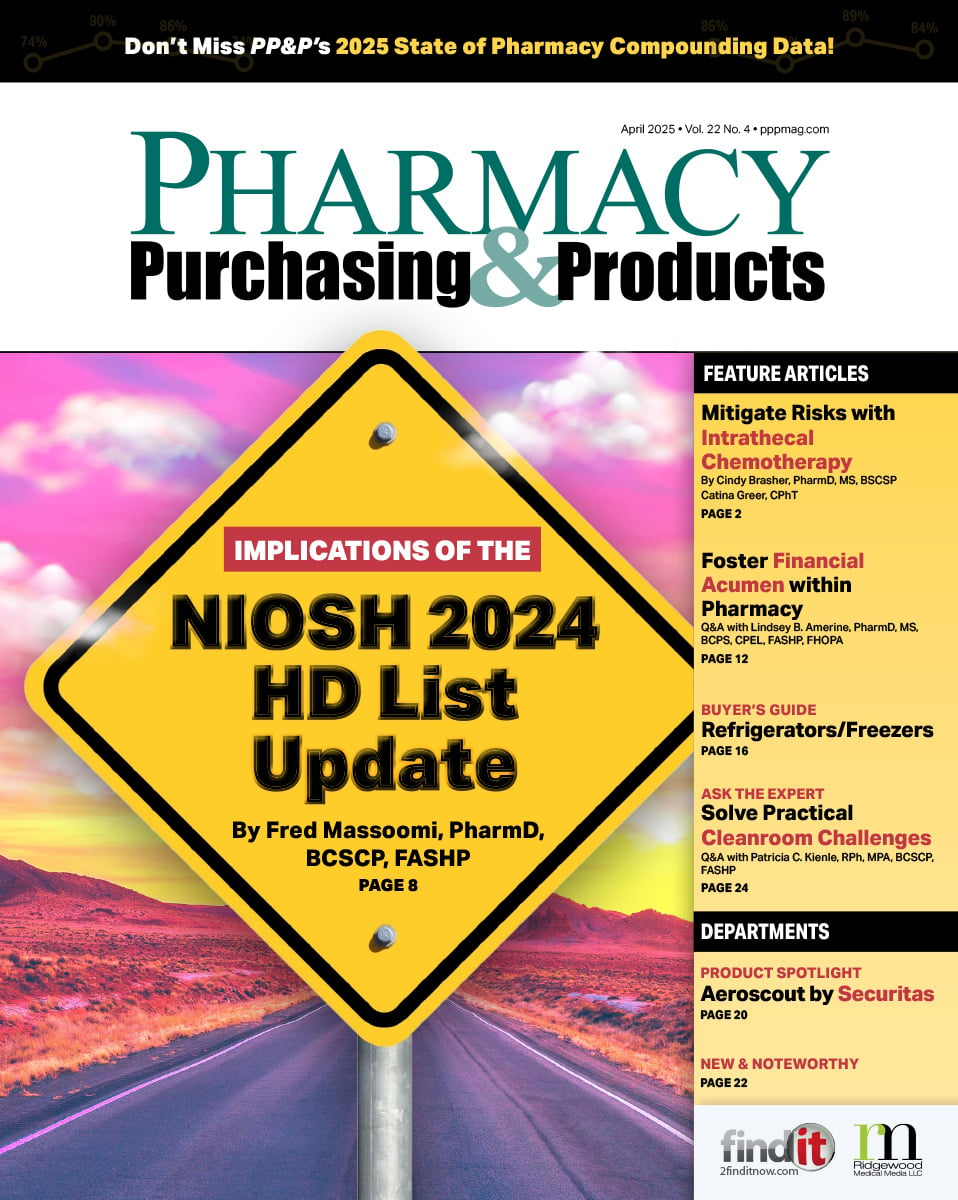- Show Menu
- Contact Us
- FAQs
- Reader Service
- Survey Data
- Survey Winners
- Testimonials
- Upcoming Events
- Webinars
- White Papers
Maximizing Central Pharmacy Dispensing Technology
In recent years, hospital pharmacies have increasingly embraced automated storage and retrieval systems. The number of organizations automating their drug storage increased to 36% in 2016, and carousel and robot systems enjoy high satisfaction ratings, with 80% of users rating their automation good or excellent.1
The Ohio State University Wexner Medical Center (OSUWMC), a 1,367 bed academic medical center located in Columbus, Ohio, comprises seven hospitals, six of which are located on the main medical center campus. The highly automated main campus has nine pharmacy dispensing areas. In December 2014, OSUWMC opened a new cancer and critical care tower with 276 acute care beds, 75 critical care beds, 80 infusion beds/chairs, and 14 operating rooms. With this expansion, OSUWMC exceeded the capacity of the existing central pharmacy distribution operation in University Hospital. Therefore, in order to safely and efficiently provide medications to the new cancer and critical care tower, the pharmacy team began an evaluation process to identify the types of pharmacy automation required for this new central pharmacy distribution area. Ultimately we chose to implement central pharmacy dispensing carousels and robots, automated dispensing cabinets, smart infusion pumps, IV compounding automation, and IV workflow automation.
Automation Requirements
The pharmacy team evaluated several vendors and ultimately decided on a robot with the following capabilities:
- Repackaging and Dispensing Non-Compounded Products. We sought a robot with the capacity to repackage and dispense unit-dose tablets from bulk bottles, as well as handle as many non-compounded products as possible, including vials, pre-filled syringes, topical products, bulk bottles of tablets, unit-dose purchased tablets, hazardous solid oral tablets, etc. The only products not stored in the dispensing technology are oversized items, such as bowel preparation kits.
- Patient-Specific Doses and ADC Replenishment. The automation also had to be able to manage both patient-specific dispensing for first-dose and cart-fill, as well as ADC replenishment.
- Bar Code Scanning, Reporting, and Inventory Management. Bar code scanning or a similar technology to validate dispensing accuracy was a top requirement. In addition, we sought automation with robust reporting features and inventory management capabilities that could assist with building the daily medication purchase order.
The suite of automation chosen for the new pharmacy includes a two-sided unit-dose repackaging and dispensing system, an ambient-temperature robot, a refrigerated robot, a dual-temperature robot, and a high-speed repackaging system.
Unit-Dose Repackaging and Dispensing System
This system is utilized for repackaging and dispensing oral tablets/capsules for patient-specific first-dose and cart-fill dispenses. An interface between the system and the EMR automates medication dispensing and eliminates human error
during the dispensing process. Bulk bottles or oral tablets and capsules are loaded into canisters using bar code technology. Once the robot repackages the tablet or capsule, a bar code printed on the package allows the system to track that tablet through its life cycle.
Dispensing Robots
The ambient-temperature and refrigerated dispensing robots dispense first-doses, cart-fill dispenses, and ADC replenishments. The interface between the EMR and the robots automates the first-dose and cart-fill dispenses from the robots, while an interface between the ADCs and the robots automates the ADC replenishment process.
The dispensing robots operate similarly to carousels, with one notable difference. When dispensing a medication, the robot brings the box containing the medication to the user, who then removes the medication from the box and scans the product; this additional validation step ensures that the correct product is removed. During this process, only a single box is available to the user. This is in contrast to a carousel, where an entire row of medication storage is available to the user. The team rated this as a significant safety benefit. Additionally, when accessing the robot, the user remains in a static location while the automation delivers the boxes to them; with the carousel, the user is required to walk the length of the carousel. As such, the robot requires less time during the dispensing process than a carousel. The robot is designed to bring the next queued-up box to the user while the user is picking from the currently available box. As soon as the user completes the pick, the next box becomes available to them.
The dual-temperature robot, which serves as the dividing wall between central pharmacy and the IV room ante area, stores the products prepared in the IV room. After a product label prints, the technician manually requests the required medications and labels the medication, if it is already in its usable form (eg, premixed IVs), or passes the label and vials into the buffer room for preparation. A benefit of positioning the robot as the divider between the two rooms is that it allows products to be loaded from the dirty side and removed from the clean side, which improves restocking efficiency and reduces the amount of cardboard introduced into the IV areas.
Repackager
The high-speed repackager is used for ADC replenishment of oral tablets, which is facilitated through an interface between the repackager and the ADCs. Following the replenishment schedule, the ADC server generates a message that is released to the repackager, which then produces a strip of medications to refill the ADC. All oral, non-controlled medications for a given ADC are produced on a single strip, with a blank package between medications to help the technician during the restocking.
Vendor Assistance
Vendor assistance was critical prior to and throughout the installation process to understand and maximize the utility of the automation. Without prior experience with a given technology, it can be difficult for pharmacy to project the impact on operations. Networking with other users can be helpful to gain insight into process optimization, as pharmacists using the technology can provide lessons learned and help translate the operational impacts of the technology in a more practical way than vendor representatives who are not pharmacists.
Implementing new automation often requires a significant adjustment period, and additional time will be necessary if substantial calibration of the machines is required. During the automation roll out, OSUWMC invested significant time optimizing the unit-dose repackaging and dispensing system. This required a team effort between the vendor installers and the pharmacy team. For example, the speed at which the unit-dose repackaging system repackages medications is customizable. We found that when repackaging at the highest speed, it is possible to damage the tablet. Therefore, we adjusted the speed to a lower setting for all repackaging.
Maximizing Utility
The pharmacy operations team worked with the robot vendor to develop a plan to fully operationalize the automation. The need to build redundancies into the system and support future growth was taken into account. For example, the unit-dose repackaging and dispensing system is capable of dual-side repackaging and dispensing functionality, which enables packaging and dispensing functions to be performed simultaneously. While repackaging is typically only performed on one side of the machine, having the option to package on both sides was a desired functionality. The dual-side dispensing functionality not only provides redundancy, but also supports pharmacy operations, allowing for first doses to continue to dispense from one side while cart-fill is running on the other.
Moreover, our ambient robot is a four-module unit. Originally we considered a five-module unit, but it would not fit in the allotted pharmacy space. The refrigerated robot is a two-module unit, while the dual-temperature machine is a three-module unit (two ambient temperature modules, one refrigerated module).
To assign medication locations, we follow the operational guideline developed during the vendor selection process. The type of medication—oral tablet, vial, or syringe—drives much of the layout. An additional consideration is whether the medication will be dispensed as a patient-specific medication or stored in an ADC; this determines whether the unit-dose repackaging and dispensing system will be utilized vs the high-speed repackaging machine. A few medications are stocked in both areas.
Addressing Implementation Challenges
Due to the opening of our new hospital, all of the automation was rolled out at one time. This intense go-live likely contributed to some of the challenges we encountered, as staff was simultaneously learning to operate in a new pharmacy, in a new hospital, with new automation. The main challenge we experienced during the go-live related to staff training. An adjustment period was necessary to bring all staff up to speed. It is important to utilize the adjustment period to modify and blend the workflow with the new automation to fully operationalize the process. Working closely with the vendor is critical to implementing enhancements to improve workflow.
When implementing any large-scale automation, many issues must be taken into account. The following considerations impacted our implementation of the automation: the purchase of a glycol chiller to cool the refrigerated robot, the proximity in the building to chilled water to cool the dual-temperature robot, and access to pneumatic air to run the unit-dose repackaging and dispensing system. In contrast to a refrigeration compressor on a standalone refrigerator, chilled glycol is used to cool the refrigerated robot to the desired temperature. Chilled water is used to cool the compressor of the dual-temperature robot. Pneumatic air is used in many steps of the unit-dose repackaging and dispensing system. Specially designed straws are used during the repackaging process to remove a tablet from the container and place it into the unit-dose bag. Pneumatic air also is used by the system to move the unit-dose bags from the repackaging station to the storage area, and from the storage area to the final dispensed ring.
Additionally, when implementing new automation, the time from vendor selection, to contract signing, to implementation is important. Understanding how much time will be required was especially important during the completion and opening of our new hospital. Given the scope of OSUWMC’s construction project, this process stretched from 4 to 5 years. It is vital to continually engage with technology vendors during this time to future-proof the automation investment. Consider that the vendor may develop a new version of the technology or enhanced features during this time period, but your original contract may be for the older technology that may be outdated when it is finally installed. Consistent vendor interaction can help avoid potential pitfalls.
Results
The technology has undergone some optimization since the original go-live, specifically in regard to the locations of medication storage. This is most apparent in the ADCs, the high-speed repackaging machine, and the unit-dose repackaging and dispensing system. As we continue to balance the inventory-carrying costs of putting medications in ADCs with the labor cost of dispensing doses from the central pharmacy, we have switched the locations of some medications. For example, in units that are high users of enoxaparin syringes, these medications are stored in ADCs. The syringes also are located in the ambient robot in central pharmacy; if a patient is on enoxaparin and located on a unit that does not have it in the ADC, the product is dispensed patient-specific from the robot to the floor. If the patient is located on a unit that has enoxaparin in the ADC, the dispense comes from that ADC. When the ADC must be replenished, a replenishment order is sent to the ambient robot and a bulk supply of syringes is sent to the ADC. This has enabled us to streamline the cart-fill process while balancing inventory-carrying costs.
One of the most significant benefits of implementing the central pharmacy dispensing technology was that we were able to successfully petition the state board of pharmacy to grant us a partial pharmacist product check exemption for doses prepared by the automation; pharmacists are now only required to check 10% of doses from the unit-dose repackaging and dispensing system (but 100% of first-dose and cart-fill dispenses from the robots) (see SIDEBAR for a full description of this process). At the time we sought this exemption, no specific guidance was available to us to establish this process. However, the team believed that the benefits of the dispensing automation put the department in a good place to receive the exemption, and we were correct.
This technology implementation has significantly increased the efficiency of pharmacy operations as well as the safety of the dispensing process. Dispensing errors from the robot are approximately one-tenth of what would occur in a manual technician pick process; in addition, when errors do occur, there is a lower likelihood of the error causing patient harm. For example, the most common error from the dispensing robot is the dispensing of a broken tablet. Typically, the nurse will catch this error; if the error is not caught, there is still a low likelihood of patient harm resulting. Alternatively, wrong drug dispenses do occur in a completely manual pick process, and these errors have a much higher likelihood of resulting in patient harm. When using our automation, we have never experienced a wrong drug error.
Future goals for the automation are to continue to optimize the equipment and expand its use to the entire medical center campus, as appropriate. We also aim to continue to demonstrate the significant safety of the automation to the board of pharmacy in order to ultimately eliminate the pharmacist product check from this segment of pharmacy operations.
Reference
- State of Pharmacy Automation Survey. Carousel and Robot Storage. Pharm Purch Prod. 2016;13(8):18-19.

Ryan W. Naseman, PharmD, MS, BCPS, is the assistant director of pharmacy at The Ohio State University (OSU) James Cancer Hospital in Columbus, Ohio, where he manages the ambulatory infusion program, investigational drug services, and nuclear pharmacy. He received his PharmD from Ohio Northern University, and an MS in health-system pharmacy administration from OSU while completing a combined PGY1/PGY2 residency in health system pharmacy administration at the OSU Wexner Medical Center.
SIDEBAR
Obtaining a Board of Pharmacy Check Exception
A major consideration in the decision to purchase and implement central pharmacy automation was the potential to eliminate the pharmacist check step for the dispensed product. During the opening of the new pharmacy, the board of pharmacy visited several times, first to authorize the new dispensing area and thereafter to work with the OSUWMC team on the pharmacist check exemption.
The approval process for this check exemption was extremely detailed and data-driven. The OSUWMC pharmacy team was required to track every single dispense from the automation, with a pharmacist check required of all doses at the outset. Any potential error was logged by pharmacists. The most common error was a broken tablet in a dispensed bag, with an occasional duplicate tablet or empty bag.
We worked with the vendor to understand why these errors were occurring. Most of these issues were resolved with minor calibration tweaks to the machine. We also discovered that many tablets arrive broken in the bulk bottle, and implemented a pre-repackaging process to eliminate the potential of a broken tablet entering the machine.
Ultimately, the board granted a partial pharmacist check exemption, which included the ADC replenishment process from the high-speed repackager and the robot, and the first-dose and cart-fill dispensing from the unit-dose repackaging and dispensing system. Pharmacists still check 10% of doses from the unit-dose repackaging and dispensing system and 100% of first-dose and cart-fill dispenses from the robots.
Systems Scoop
- Electronic Medical Record: Epic
- Smart Pumps: BD's Alaris
- ADCs: BD's Pyxis ES
- Dispensing Robot: Swisslog's BoxPicker
- Carousels: Aesyn'ts MedCarousels
- High-Speed Repackaging Machine: TCGRx/ATP
- Automated Packaging and Dispensing System: Swisslog's PillPick
- IV Chemotherapry Compounding Automation: Apoteca
- IV Workflow Automation: Apoteca
Like what you've read? Please log in or create a free account to enjoy more of what www.pppmag.com has to offer.








